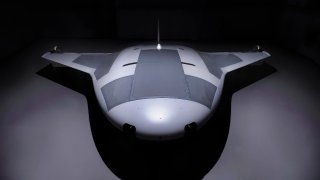Northrop Grumman Manta Ray Could be the Future of the U.S. Navy
The U.S. Navy's future fleet may transition from traditional warships and submarines to a more innovative force featuring Uncrewed Underwater Vehicles (UUVs) like the "Manta Ray."
Summary: The U.S. Navy's future fleet may transition from traditional warships and submarines to a more innovative force featuring Uncrewed Underwater Vehicles (UUVs) like the "Manta Ray." Northrop Grumman has unveiled a prototype of this extra-large glider UUV, designed to perform long-duration, payload-capable missions undersea without human support, a breakthrough achieved through a DARPA program. Resembling its namesake, the Manta Ray is equipped with dual rear propellers, capable of operating in deep oceanic regions beyond human reach, developed in collaboration with the renewable energy company Seatrec. This modular UUV, potentially serving as a mother ship for smaller UUVs, could undertake roles in undersea mapping, mine detection, and passive surveillance, enhancing maritime security. Alongside the recently introduced Orca XLUUV by Boeing, the Manta Ray represents the Navy's shift towards autonomous, versatile undersea platforms for dominance in contested waters.
Manta Ray: The U.S. Navy's Future?
The United States Navy of the future will not consist of a fleet of massive battleships. Instead, it could include dozens, perhaps even hundreds of "Manta Rays" – not the large "winged fish that frequent tropical waters, but an Uncrewed Underwater Vehicle (UUV) that does sort of resemble the creatures.
Northrop Grumman recently completed the assembly of its full-size Manta Ray UUV prototype, and on Monday released the first image of the UUV.
"A new class of UUV, it is an extra-large glider that will operate long-duration, long-range and payload-capable undersea missions without need for on-site human logistics," the aerospace and defense firm announced. "Manta Ray was built through a Defense Advanced Research Projects Agency (DARPA) program aimed at advancing key technologies to benefit future UUV designs, including techniques to manage energy, increased payload capacity, low-power propulsion and more."
Its design was modeled on the aquatic creature, and it is reported to be outfitted with two rear propellers for movement, while it was also designed to operate for extended periods in oceanic environments inaccessible to humans. The UUV was developed in partnership with Seatrec – a renewable energy company – to enhance the understanding of marine environments and operate independently for extended periods.
According to Northrop Grumman, it is "payload-capable to support a variety of missions," while it can operate without the need for on-site human logistics. It can anchor to the seafloor and hibernate in a low-power state, while it is also modular, which could allow for different mission-specific components.
The U.S. Navy hasn't disclosed exactly what roles the UUV could be employed in, nor have the dimensions of the Manta Ray been disclosed. However, it is apparently large enough that it could serve as a mother ship for smaller UUVs. It was designed for easy transport and assembly on-site from five standard shipping containers, so it could likely be launched from a dock or even a ship at sea.
There is speculation that the Mantra Ray could be outfitted to conduct undersea mapping, mine detection, and passive surveillance. In the latter role, it could be utilized to monitor for underwater threats to a carrier strike group or even aid in protecting commercial shipping.
Northrop Grumman was awarded a Phase 2 contract in 2021 to continue work on the Manta Ray program that began a year earlier. Phase 2 called for North Grumman Systems Corporation and Martin Defense Group to each build a full-scale tech demonstrator.
According to DARPA, during Phase 1 of the program, performers designed and conducted preliminary testing on novel approaches in energy management, UUV reliability, biofouling and corrosion control, navigation, and undersea obstacle avoidance, among other areas that directly enable long-endurance missions.
Aquatic Platforms
The Manta Ray isn't the only UUV being developed for the U.S. Navy, and it was in December that the sea service received its first Orca extra-large unmanned underwater vehicle (XLUUV) from Boeing. More than a decade of pioneering work went into developing Orca, a new class of autonomous submarines that can perform long-duration critical missions in contested and changing waters. The Orca XLUUV can perform long-duration critical missions to achieve undersea maritime dominance in changing environments and contested waters.
The U.S. Navy had called for the XLUUV to be adaptable so that it could perform surveillance, submerged, surface, and electronic combat, as well as minesweeping operations.
Author Experience and Expertise: Peter Suciu
Peter Suciu is a Michigan-based writer. He has contributed to more than four dozen magazines, newspapers, and websites with over 3,200 published pieces over a twenty-year career in journalism. He regularly writes about military hardware, firearms history, cybersecurity, politics, and international affairs. Peter is also a Contributing Writer for Forbes and Clearance Jobs. You can follow him on Twitter: @PeterSuciu.
You can email the author: [email protected].


